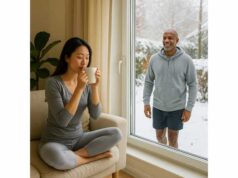
Aging cells do not simply fade into the background. Some stop dividing, change their shape, and begin broadcasting distress signals that affect nearby tissue. This state—cellular senescence—shows up in many tissues with age and chronic disease. It can help or harm, depending on timing and load. The secreted mix of cytokines, enzymes, lipids, and growth factors known as the senescence-associated secretory phenotype (SASP) is the key reason senescence matters for real-world health: it can coordinate repair or drive chronic inflammation. If you want practical leverage for healthy aging, start by understanding what pushes cells toward senescence, which daily habits tune those signals down, and when restraint is wiser than force. For a broader foundation on how cellular stress pathways integrate with metabolism, visit our overview of cellular stress and longevity pathways.
Table of Contents
- What Senescent Cells Are and Why the SASP Matters
- Why Cells Go Senescent: Damage, Inflammation, and Replicative Limits
- Lifestyle Levers that Reduce Excess Stress Signals
- Movement, Sleep, and Weight: The Everyday Anti-SASP Trio
- Safety First: Why Not All Senescent Cells Are “Bad” to Remove
- Where This Fits: Foundations Before Advanced Therapies
- Practical Checklist: Small Wins that Lower Cellular Stress
What Senescent Cells Are and Why the SASP Matters
Cellular senescence is a protective state: cells exit the cell cycle and resist division in response to stress, DNA damage, telomere problems, or oncogene activation. In early life or after acute injury, this response lowers cancer risk and can guide wound repair by recruiting immune cells and shaping the extracellular matrix. That is the “good” face of senescence—short-lived, task-focused, and cleared once the job is done.
The challenge appears when senescent cells accumulate and linger. Instead of a brief, coordinated signal, you get a continual broadcast of the SASP—a cocktail of pro-inflammatory cytokines (such as IL-6 and IL-1 family members), chemokines, matrix-remodeling enzymes (MMPs), growth factors, lipid mediators, extracellular vesicles, and even DNA fragments. The SASP is not a single profile. Its composition depends on cell type, the trigger that induced senescence, and the tissue environment. That variability explains why senescence can both support tissue repair and fuel chronic disease.
Several features make the SASP biologically powerful:
- Paracrine spread: SASP factors can push nearby cells toward senescence or dysfunction, creating “hot spots” of aging phenotypes in tissues.
- Immune crosstalk: SASP signals recruit immune cells for cleanup. If the immune system is robust, senescent cells are cleared. If not, the loop stalls and SASP persists.
- Tissue remodeling: Matrix enzymes and growth factors alter structure and signaling—helpful in wound healing, harmful when chronic.
- Systemic spillover: Persistent SASP correlates with low-grade inflammation and metabolic disruption, touching organs far from the original stress.
Markers often used to identify senescent cells include p16^INK4a, p21^Cip1, senescence-associated β-galactosidase (SA-β-gal), DNA damage foci (e.g., γ-H2AX), and loss of lamin B1. None is perfect alone; combinations strengthen confidence. Importantly, senescence is a state, not a single marker. What matters for health is the balance between the beneficial, time-limited senescence that supports repair, and the persistent, SASP-rich senescence that degrades resilience.
In practice, lifestyle and medical choices should aim to lower the chronic SASP burden while preserving the protective, short-term roles of senescence in defense and repair. That balance starts with understanding why cells enter this state in the first place.
Why Cells Go Senescent: Damage, Inflammation, and Replicative Limits
Senescence is not random; it is a programmed response to cumulative stress. Three broad inputs dominate.
- Genomic and mitochondrial damage. Persistent DNA damage—double-strand breaks, stalled replication forks, or telomere attrition—activates p53, p21, and p16 pathways that enforce arrest. Mitochondrial dysfunction raises reactive oxygen species, further feeding DNA damage and SASP gene expression. The cGAS–STING innate immune pathway senses leaked nuclear or mitochondrial DNA fragments and can supercharge SASP production. This “danger DNA” signal helps explain the switch from a quiet arrest to an inflammatory secretory phenotype.
- Inflammatory and metabolic stress. Chronic overnutrition, high glycemic load, and visceral adiposity create a pro-inflammatory environment. Adipose tissue under strain becomes hypoxic, secretes more inflammatory cytokines, and sheds extracellular vesicles that carry SASP-like messages. Macrophages in overloaded fat depots adopt a pro-inflammatory profile, and insulin resistance grows. Over time, these conditions promote senescence in adipocytes, preadipocytes, endothelial cells, and immune cells, compounding the signal.
- Replicative limits and context. Some cell types face replicative ceilings (telomere-linked) or repeated cycles of activation, injury, and repair (muscle satellite cells, epithelial barriers). With age, repair becomes noisier and less coordinated. When damage outpaces clearance, senescent cells persist. “Therapy-induced” senescence can also follow chemotherapy, radiation, or harsh oxidative exposures, producing a strong SASP unless supported recovery clears the burden.
Two nonobvious drivers link lifestyle to senescence load:
- Circadian disruption. Sleep restriction, social jet lag, and late-night light dysregulation alter clock genes that intersect with DNA damage responses, mitochondrial function, and immune surveillance. When the daily rhythm is off, the cleanup crew arrives late and leaves early; SASP lingers.
- Redox oversimplification. Blunt, high-dose antioxidant use around training or heat stress can, paradoxically, block the adaptive signaling that strengthens defenses. Better results come from dialing down excess oxidative load (ultra-processed food, sleep debt, chronic stress) while preserving hormetic signals that build capacity. For a deeper dive on balancing reactive species and adaptation, see our guide to redox balance.
The practical takeaway: it is easier to prevent persistent SASP than to reverse it. Move upstream—reduce chronic inflammatory inputs, improve mitochondrial “housekeeping,” and keep circadian timing intact—so the senescence program can do its short-term job and then switch off.
Lifestyle Levers that Reduce Excess Stress Signals
You cannot supplement your way out of senescence. The strongest levers are behavioral and environmental. Think like an engineer: remove the main loads, then add small, repeatable stresses that teach tissues to adapt.
1) Glycemic steadiness. Large, frequent glucose spikes drive oxidative stress and inflammatory signaling that reinforce SASP. Helpful patterns:
- Prioritize protein (1.2–1.6 g/kg/day) and fibrous vegetables at meals.
- Front-load calories earlier in the day, when insulin sensitivity is higher.
- Use a 10–15 minute walk after larger meals to increase glucose disposal.
2) Sleep regularity. Aim for a consistent sleep window and morning light exposure. Keep the last hour before bed low on blue-enriched light and high in predictability. Sleep regularity (bed and wake within ~60 minutes across the week) is a stronger signal to your circadian system than any gadget or supplement.
3) Movement as a baseline, not a “workout.” Sitting 8–10 hours while squeezing in a single high-intensity session leaves the inflammatory background unchanged. Insert movement “snacks” (3–5 minutes) every 60–90 minutes: stairs, brisk corridors, body-weight mobility. This preserves capillary function, keeps glucose peaks smaller, and maintains lymph flow that helps clear cellular debris.
4) Environmental dose management. Heat, cold, and hypoxia can be useful hormetic signals when small and consistent. Heat supports vascular function and heat-shock protein expression; cold can enhance brown adipose activity and insulin sensitivity. Both should be introduced gradually, with rest days and adequate hydration.
5) Protein distribution and muscle. Senescent-prone tissues stabilize when muscle mass is maintained. Distribute protein across 2–3 meals with at least ~0.4 g/kg/meal to reach leucine thresholds for muscle protein synthesis. Pair with resistance training two or three days per week.
6) Recovery rules. Recovery is when clearance happens. If you stack stressors (long fast + HIIT + sauna) without easy days, you risk amplifying SASP. Keep one day clearly easier than the rest. Separate high-intensity efforts by at least 48 hours if you are over 40 or new to training.
If you enjoy planning, map these levers onto a simple, personalized stress-dose framework. Start low, track responses, and progress only when sleep, mood, and training quality remain stable. For structure on dosing, see our guide to minimum effective dose.
Movement, Sleep, and Weight: The Everyday Anti-SASP Trio
This trio controls most of your background inflammatory tone and therefore your persistent SASP burden. The interventions below are simple, measurable, and scalable.
1) Movement: aerobic base plus strength.
Build a weekly base of 120–180 minutes of conversational-pace cardio (Zone 2 by breathing: you can speak in full sentences) and two strength sessions covering major movement patterns (squat, hinge, push, pull, carry). Zone 2 improves mitochondrial efficiency and endothelial function, reducing oxidative stress for the same workload. Strength preserves muscle fibers and satellite cell pools, improving glucose buffering. Progress slowly: add 10–15 minutes of Zone 2 per week and one set per lift every two weeks until you reach your baseline target.
2) Sleep: regularity beats perfection.
The most realistic high-leverage target is a stable sleep window (for example, 23:00–07:00 within ±30 minutes) for five or more nights per week. Add two anchors:
- Morning light: get outdoors within 60 minutes of waking for 5–10 minutes.
- Evening dim: last hour without overhead bright light; use warmer, lower-intensity lamps.
Measure by behaviors, not gadgets: bedtime and wake time (yes/no within your window), number of night awakenings, and how you feel at 10:00 and 16:00 (alert, neutral, or dragging).
3) Weight: waist before weight.
Visceral fat is metabolically active and SASP-amplifying. Instead of chasing the scale, track waist at the navel each week under the same conditions. A realistic glidepath is 0.3–0.7% of body weight per week if you aim to reduce adiposity. Combine modest energy deficit with high protein (1.2–1.6 g/kg/day), resistance training, daily steps (7,000–10,000), and meal timing that avoids late-night caloric loading.
Putting it together.
- A weekday template: 30–45 minutes Zone 2 on two days, 20–30 minutes brisk walking on two days, and two 40–60 minute strength sessions (e.g., Tue/Fri).
- Micro-habits: stand and stretch every 60–90 minutes, 10–15 minute post-meal walk, and a short wind-down routine nightly.
Energy systems, mitochondrial function, and NAD turnover all respond to these basics. If you want an accessible primer on cellular energetics and why movement plus protein makes your cells “younger,” see why daily habits support cellular energy.
Safety First: Why Not All Senescent Cells Are “Bad” to Remove
It is tempting to view senescent cells as simply harmful and to assume that more removal is always better. Biology is subtler. Senescence is involved in embryonic development, tissue remodeling, and wound healing. Short-lived senescent cells help coordinate cleanup and limit fibrosis. “Firefighting” SASP is adaptive when it appears briefly and is cleared.
Problems arise when clearance fails. Aging immune systems, chronic metabolic stress, and repeated injuries allow senescent cells to persist. Persistent SASP reshapes tissues in maladaptive ways—stiffening matrix, recruiting inflammatory cells, and inhibiting stem cell function. That is precisely why lifestyle-level reductions in inflammatory load and improvements in recovery are the safest first steps.
What about drugs that target senescence pathways? Senolytics (agents that preferentially eliminate senescent cells) and senomorphics (agents that dampen SASP without killing the cell) are active areas of research. Early human studies and many animal experiments are promising, but contexts differ widely by tissue, trigger, and timing. Off-label or do-it-yourself use can unintentionally remove cells that are performing necessary roles in repair or defense, especially near recent injuries or in tissues with slow turnover.
Practical safety rules:
- Respect timing. After acute injury or surgery, do not chase aggressive “senescence clearing.” Give the natural repair window time to run its course.
- Prefer foundations. Sleep regularity, aerobic base, strength, and weight management reduce the drivers of persistent SASP. They also improve immune surveillance—the body’s own way to clear senescent cells.
- Watch for over-stacking. Combining intense fasting, high-volume training, heat, and cold in the same week can create excessive stress and rebound inflammation. Rotate stressors and keep easy days.
- Medical context matters. Cardiometabolic disease, autoimmune conditions, cancer history, and polypharmacy all change risk-benefit calculus. Decisions about experimental agents belong with a clinician who knows your case.
To understand how your cells recycle and repair without external agents, start with autophagy basics. Leaning into the body’s built-in maintenance systems is usually the safest path to a lower SASP burden.
Where This Fits: Foundations Before Advanced Therapies
Senescence spans oncology, cardiometabolic disease, neurodegeneration, and skin health. That breadth makes it easy to chase complex solutions too early. A more effective strategy is a layered approach:
Layer 1 — Remove drivers.
- Reduce visceral adiposity with steady habits: protein at meals, daily walking, resistance training twice weekly, earlier eating windows, and limited late-evening calories.
- Keep circadian timing consistent: the same sleep window most nights, bright morning light, and dim evenings.
- Smooth glucose variability: meal composition and post-meal walks.
- Avoid “noise” that raises inflammatory tone: tobacco, heavy alcohol intake, and sleep debt.
Layer 2 — Add adaptive signals, gently.
- Build an aerobic base (Zone 2) and basic strength.
- Consider gradual heat or cold exposure if blood pressure, cardiovascular status, and personal risk allow. Start with small doses and rest days.
- Add mobility and impact-appropriate loading (hiking, stair climbing, light jumps if joints permit) to maintain bone and connective tissue signaling.
Layer 3 — Monitor stability.
- Track simple metrics (see next section) and adjust dose before problems snowball.
- If new symptoms arise—unexplained fatigue, repeat infections, stalled wound healing—pause stressors and prioritize sleep and nutrition.
Layer 4 — Specialist care.
- Discuss advanced therapies (pharmacologic senolytics/senomorphics, clinical-trial enrollment) with a clinician who can weigh comorbidities and medications.
- Do not mix unvetted compounds with high-dose training blocks or caloric restriction. The interactions can be unpredictable.
If you want a step-by-step blueprint that stays repeatable across busy weeks, our guide to building a sustainable hormesis plan can help you set doses, sequence stressors, and choose recovery anchors that make the basics automatic.
Practical Checklist: Small Wins that Lower Cellular Stress
Use this checklist to translate the science into actions you can sustain. Aim for consistency over intensity.
Daily anchors
- Wake routine (10 minutes): outdoor light within an hour of waking; 5–10 slow nasal breaths; glass of water.
- Meal basics: include a palm-sized protein at each meal; fill half the plate with fibrous vegetables; add olive oil, nuts, or avocado for satiety.
- Movement snacks: 3–5 minutes every 60–90 minutes—stairs, brisk walk, mobility flow.
- Post-meal walk: 10–15 minutes after your largest meal.
- Evening wind-down (30–45 minutes): dim lights, screens off or filtered, light stretching or reading.
Weekly rhythm
- Cardio: 2–3 sessions of Zone 2 (20–45 minutes each) and 1 optional interval session if you wake rested and recover well.
- Strength: 2 full-body sessions, 6–10 work sets total per session.
- Easy day: at least one day with steps, mobility, and no structured training.
- Optional heat or cold: 1–2 light exposures (e.g., warm bath or cool shower), separated from intense training days.
Environmental and behavioral noise reduction
- Limit ultra-processed food to occasional use; cook most of your meals.
- Keep alcohol to low levels or avoid it entirely, particularly within 3 hours of bedtime.
- Protect sleep from weekend drift; keep bed and wake times within 60 minutes of weekdays.
- Plan recovery in your calendar the way you schedule workouts.
Self-check each week
- Did I hit my sleep window at least five nights?
- Did I complete two strength sessions and at least 120 minutes of steady-state movement?
- Did I have at least one truly easy day?
- Is my waist trending down (if reducing adiposity is a goal) or stable (if maintenance is the goal)?
- Energy at 10:00 and 16:00: mostly alert, or consistently dragging?
Small wins compound. Reducing the background stress that drives SASP lightens the load on repair systems, making every other intervention more effective.
References
- The roles and mechanisms of senescence-associated secretory phenotype (SASP): can it be controlled by senolysis? 2022 (Systematic Review)
- Cellular senescence and the tumour microenvironment 2022 (Review)
- Targeting cellular senescence in metabolic disease 2022 (Review)
- Increased cell senescence in human metabolic disorders 2023 (Review)
- Role of Senescent Cells in Cutaneous Wound Healing 2022 (Review)
Disclaimer
This article is for educational purposes and does not replace personalized medical advice, diagnosis, or treatment. Decisions about exercise programs, fasting, heat or cold exposure, and any medical therapy should be made with a qualified healthcare professional who understands your medical history and current medications.
If you found this helpful, please consider sharing it with a friend or colleague on Facebook, X, or any platform you use, and follow our work for future updates. Your support helps us continue producing clear, practical health content.










